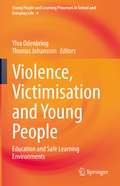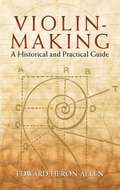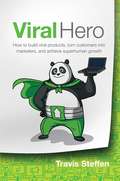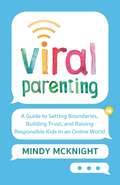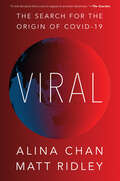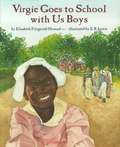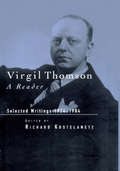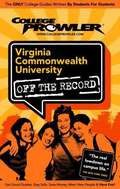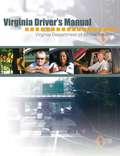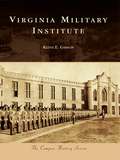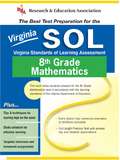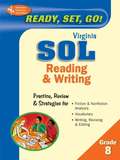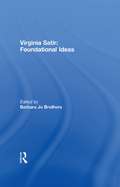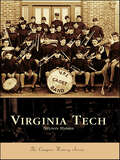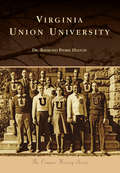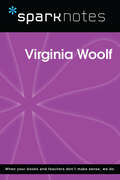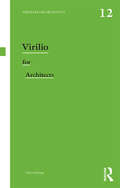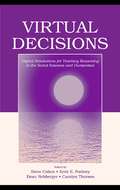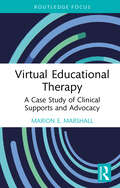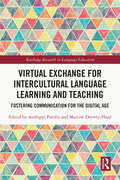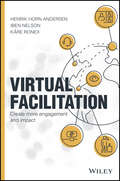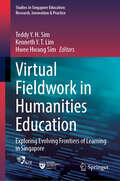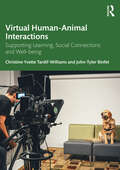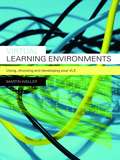- Table View
- List View
Violence, Victimisation and Young People: Education and Safe Learning Environments (Young People and Learning Processes in School and Everyday Life #4)
by Thomas Johansson Ylva OdenbringThis edited collection focuses on different aspects of everyday violence, harassment and threats in schools. It presents a number of in-depth studies of everyday life in schools and uses examples and case studies from different countries to fuel a discussion on national differences and similarities. The book discusses a broad range of concepts, findings and issues, under the umbrella of three main themes: 1) Power relations, homosociality and violence; 2) Sexualized violence and schooling; and 3) Everyday racism, segregation and schooling. Specific topics include sexuality policing, bullying, sexting, homophobia, and online rape culture. The school is young people’s central workplace, and therefore of great importance to students’ general feeling of wellbeing, safety and security. However, there is no place where youth are at greater risk of being exposed to harassment and violations than at school and on their way to and from school. Threats are a relatively common experience among school students, but some aspects of these mundane and frequent harassments and violations are not taken seriously and are, therefore, not reported. Harassment and violations often have negative effects on youth and children, and increase their risks of such adverse outcomes as school dropout, drug use, and criminal behaviour. Contemporary research has shown that gender is of great importance to how students handle and report, or do not report, various violent situations. Studies have also revealed how the notions of masculinity and of being a victim can be conflicting identities and affect how students handle situations of threat, violence and harassment. The importance of gender is also particularly evident with regard to sexual harassment. Female students generally report greater exposure to sexual harassment than male students do.
Violin-Making: A Historical and Practical Guide
by Edward Heron-AllenThis classic guide offers an accessible initiation into the mysteries of violin-making. Charming in its style and cultivated in its research, it covers every detail of the process, from wood selection to varnish. A fascinating history of the instrument precedes discussions of materials and construction techniques. More than 200 diagrams, engravings, and photographs complement the text.Author Edward Heron-Allen served an apprenticeship with Georges Chanot, a preeminent nineteenth-century violin maker. The knowledge, skill, and experience Heron-Allen acquired in the master's shop are reflected in this book, which was the first to combine the history, theory, and practice of violin-making. Originally published in 1884 as Violin-Making, As It Was and Is: Being a Historical, Theoretical and Practical Treatise on the Science and Art of Violin-Making for the Use of Violin Makers and Players, Amateur and Professional, this volume has enlightened and informed generations of performers and players alike.
Viral Hero: How to build viral products, turn customers into marketers, and achieve superhuman growth
by Travis SteffenIn Viral Hero, serial entrepreneur and growth engineer Travis Steffen reveals his comprehensive, battle-tested strategy for building products capable of true viral growth. If you think “viral marketing” only refers to making videos or memes to get shares on social media, there’s a reason you’ve found it difficult to grow your business. In Viral Hero, serial entrepreneur and growth engineer Travis Steffen reveals his comprehensive, battle-tested strategy for building products capable of true viral growth. Developed over years of research and more than a decade of starting, growing, and selling startups, Viral Hero includes a detailed breakdown of the many types of viral marketing, their various techniques and strategies, clear explanations of abstract and often misunderstood theories, simple tactics for measuring and predicting your viral growth, and actionable steps for making your product spread like wildfire. Using detailed examples from real high-growth companies, Viral Hero is a comprehensive, approachable resource that gives you all the tools you’ll need on your journey toward becoming a viral hero for your business.
Viral Parenting: A Guide to Setting Boundaries, Building Trust, and Raising Responsible Kids in an Online World
by Mindy McKnightMindy McKnight, YouTube's favorite mom, shares the tools parents need to keep kids safe in their online lives--and shows how to create stronger family relationships as they do. A cross between Jen Hatmaker and Rosalind Wiseman, VIRAL PARENTING is a guide to raising responsible, safe, and communicative kids in the digital world. Mindy shares practical tools for having honest conversations with kids of all ages about privacy, bullying, respectfulness, and family time, while emphasizing the importance of trust and open communication. These strategies are timeless--whether applied to texting, snapping, Facebooking, kiking, or whatever social media platforms await us in the future, this book is ultimately about teaching children about personal responsibility and safety. Mindy shares practical tools for creating family rules for kids of all ages about privacy, bullying, respectfulness, and family time, while emphasizing the importance of trust and open communication. Using family contracts, guided conversations, device checks, and respectful but firm oversight, the McKnights have raised a close knit family and navigated the complexity of being world-wide internet celebrities with grace. McKnight will show any parent of any child or teen how that's done--setting non-negotiable guidelines and offering a savvy perspective toward privacy that audience have been begging for.
Viral: The Search for the Origin of Covid-19
by Matt Ridley Alina Chan"Chan and Ridley write with an urgency...that inspires gripping depictions of what viruses are, how infectious-disease laboratories work and wonderfully lucid descriptions of bats. . . . They powerfully recount how dangerous pathogens can both leak from a lab and emerge in nature." (New York Times Book Review) Understanding how Covid-19 started is crucial for the future of humankind. Viral is the most incisive and authoritative book about the search for the source of the virus.A new virus descended on the human species in 2019 wreaking unprecedented havoc. Finding out where it came from and how it first jumped into people is an urgent priority, but early expectations that this would prove an easy question to answer have been dashed. Nearly two years into the pandemic, the crucial mystery of the origin of SARS-CoV-2 is not only unresolved but has deepened. In this uniquely insightful book, a scientist and a writer join forces to try to get to the bottom of how a virus whose closest relations live in bats in subtropical southern China somehow managed to begin spreading among people more than 1,500 kilometres away in the city of Wuhan. They grapple with the baffling fact that the virus left none of the expected traces that such outbreaks usually create: no infected market animals or wildlife, no chains of early cases in travellers to the city, no smouldering epidemic in a rural area, no rapid adaptation of the virus to its new host—human beings. To try to solve this pressing mystery, Viral delves deep into the events of 2019 leading up to 2021, the details of what went on in animal markets and virology laboratories, the records and data hidden from sight within archived Chinese theses and websites, and the clues that can be coaxed from the very text of the virus’s own genetic code. The result is a gripping detective story that takes the reader deeper and deeper into a metaphorical cave of mystery. One by one the authors explore promising tunnels only to show that they are blind alleys, until, miles beneath the surface, they find themselves tantalisingly close to a shaft that leads to the light.
Virgie Goes to School with Us Boys
by Elizabeth Fitzgerald HowardAll Virgie wants to do is go to school with her five older brothers, who think she's too small and that girls don't need an education.
Virgil Thomson: A Reader: Selected Writings, 1924-1984
by Richard KostelanetzThis essential reader includes Thomson's essays on making a living as a musician; his articles on classic composers; his relation to his contemporaries; his articles on newcomers in the music world, including John Cage and Pierre Boulez; his autobiographical writings and commentary on his own works.
Virginia Commonwealth University (College Prowler)
by Carrie LeflerNo university affiliations. No half-truths. No out-of-touch authors who haven't been in school for decades. A class project turned company, College Prowler produces guidebooks that are written by actual college students and cover the things students really want to know. Unlike other guides that jam everything into a five-pound book and devote only two pages to each college, our single-school guidebooks give students only the schools they want and all the information they need. From academics and diversity to nightlife and sports, we let the students tell it how it is. In addition to editorial reviews and grades for 20 different topics, more than 80 percent of each guide is composed of actual student reviews of their school. Whether readers are looking for Best and Worst lists, Did You Knows? or traditions, College Prowler guides have it all. Our books are the only place for local slang, urban legends, and tips on the best places to find a date, study, or grab a bite to eat.
Virginia Driver's Manual
by Virginia Department of Motor Vehicles<p>The Virginia Driver's Manual will help you learn and understand safe driving practices. Study this manual to prepare for the knowledge test, obtain a Virginia driver's license and become a safe driver. <p>The information contained in this manual should be used as a general guide to the motor vehicle laws but not as a substitute for the Code of Virginia, which contains the laws that govern Virginia drivers and vehicles. <p>If you are learning to drive, this manual will give you information you need to study for the knowledge exam. If you already have a Virginia driver's license, review this manual for new laws or rules of the road. <p>Driving is a privilege, not a right. Your driver's license carries with it a great responsibility to be courteous of other drivers on the roadways and follow state and federal motoring laws. This manual is also available on the DMV website, www.dmvNOW.com. <p>DMV offers the Virginia Driver's Manual in an audio format for Virginians with special needs. The audio version is available at www.dmvNOW.com.</p>
Virginia Military Institute (Campus History)
by Keith E. GibsonIn 1839, the Virginia Military Institute became the nation's first state-sponsored military college when the state arsenal in Lexington, Virginia, adopted an additional duty providing a college education to a small group of cadets. This humble experiment became the nation's model for educating the citizen-soldier. Today cadets live a military lifestyle while pursuing an undergraduate degree and may choose to accept a commission in any branch of the armed forces upon graduation. Noted alumni include Pony Express organizer Ben Ficklin (1849), Nobel Peace Prize recipient Gen. George Marshall (1901), Polar explorer Adm. Richard Byrd (1908), U.S. Supreme Court Justice Tom Clark (1921), and actor Dabney Coleman (1957). Numbered among the alumni are over 260 general officers, 13 Rhodes Scholars, and a saint in the Episcopal Church. The Post, as the campus is called, is a National Historic District with its distinctive Gothic Revival architecture surrounding the central parade ground.
Virginia SOL Grade 8 Math (Virginia Sol Test Preparation Ser.)
by Stephen HearneREA … Real review, Real practice, Real results. REA's Virginia Grade 8 SOL Math Study Guide! Fully aligned with Virginia’s Core Curriculum Standards Are you prepared to excel on this state high-stakes assessment exam? * Take the diagnostic Pretest and find out what you know and what you should know * Use REA's advice and tips to ready yourself for proper study and practice Sharpen your knowledge and skills * The book's full subject review refreshes knowledge and covers all topics on the official exam and includes numerous examples, diagrams, and charts to illustrate and reinforce key math lessons * Smart and friendly lessons reinforce necessary skills * Key tutorials enhance specific abilities needed on the test * Targeted drills increase comprehension and help organize study * Color icons and graphics highlight important concepts and tasks Practice for real * Create the closest experience to test-day conditions with a full-length practice Posttest * Chart your progress with detailed explanations of each answer * Boost confidence with test-taking strategies and focused drills Ideal for Classroom, Family, or Solo Test Preparation! REA has helped generations of students study smart and excel on the important tests. REA’s study guides for state-required exams are teacher-recommended and written by experts who have mastered the test.
Virginia SOL, Reading & Writing, Grade 8 (Virginia Sol Test Preparation Ser.)
by The Editors of REA Dana PassanantiREA ... Real review, Real practice, Real results. REA's Virginia Grade 8 SOL Reading & Writing Study Guide! Fully aligned with the Virginia Department of Education Standards of Learning Are you prepared to excel on this state high-stakes assessment exam? * Take the diagnostic Pretest and find out what you know and what you should know * Use REA's advice and tips to ready yourself for proper study and practice Sharpen your knowledge and skills * The book's full subject review refreshes knowledge and covers all topics on the official exam, including vocabulary, literary analysis, drafting, revising, and editing to reinforce key English language lessons * Smart and friendly lessons reinforce necessary skills * Key tutorials enhance specific abilities needed on the test * Targeted drills increase comprehension and help organize study * Color icons and graphics highlight important concepts and tasks Practice for real * Create the closest experience to test-day conditions with a full-length practice Posttest * Chart your progress with detailed explanations of each answer * Boost confidence with test-taking strategies and focused drills Ideal for Classroom, Family, or Solo Test Preparation! REA has helped generations of students study smart and excel on the important tests. REA's study guides for state-required exams are teacher-recommended and written by experts who have mastered the test.
Virginia Satir: Foundational Ideas
by Barbara Jo Brothers“Amid these [world] changes is the growing conviction that human beings must evolve a new consciousness that places a high value on being human, that leads toward cooperation, that enables positive conflict resolution, and that recognizes our spiritual foundations. Can we accept as a given that the self of the therapist is an essential factor in the therapeutic process? If this turns out to be true, it will alter our way of teaching therapists as well as treating patients.” (Virginia Satir in The Use of Self in Therapy, The Haworth Press, Inc., 1987Virginia Satir, an internationally renowned educator and master therapist and a pioneer in the field of family therapy, altered the way therapists are taught and patients are treated. This landmark volume focuses on the important contributions that she made to the therapy profession. Written and edited by therapists who trained and worked closely with her, Virginia Satir: Foundational Ideas reflects her most basic ideas about the healing quality of respect for all people and the emphasis on the personal aspects of treatment rather than the technical. It also addresses the necessity of emotional honesty between the therapist and the patient and illustrates these therapists’impact on therapy as it is practiced today.The legacy left by Dr. Satir includes her profound insight into the behavior of human beings and the guidelines for the application of universal principles in such a way as to enhance human growth and unite individuals. Her impact on therapists around the world is apparent upon reading this triumphant volume. Scholars and practitioners address some of the fundamental tenets of therapy as developed by Dr. Satir and explain how they have integrated these basic foundations into their own practices. The highlights of her professional contributions that are discussed in this exhaustive volume include: the basic patterns of communication that are common to all people and the relationship of communication and self-esteem the triad concept and strategies for teaching people to exist in this basic unit of humankind in a healthy way the parts party and how this process for integrating various aspects of a person can be used with couples as well the model for change process and the ways in which it can be used with individuals, couples, and the world family reconstruction and the value of acting out the past with the therapist as guideVirginia Satir: Foundational Ideas is a sharp, clear focus on the person and work of this great master. It is necessary reading for all professionals around the world who seek to better understand the therapy process and the keys to its success.
Virginia Tech (Campus History)
by Nelson Harris130 years after its opening, the once small agricultural college has become Virginia's largest university- Virginia Polytechnic Institute and State University.When Charles Minor opened the doors of his new land-grant institution in late 1872, there were only 29 students, 3 faculty members, and a single building in the town of Blacksburg, Virginia. From the humble beginning of donated livestock, seeds, machinery, and books, the university now known as Virginia Tech has emerged as a leading research university that is consistently ranked among the nation's best colleges. In addition to housing some of the top engineering and business schools, the university also has a tremendous athletic program that continually produces many of the nation's top ranked athletes. The Campus History Series: Virginia Tech illustrates the university's evolution through over 200 archival photographs, including rare and fun bites of campus history, such as the old cadet rat parades, the first ring dance, the Highty-Tighties, the Huckleberry, and even the evolution of the school's mascot, the Hokie Bird.
Virginia Union University
by Dr Raymond HyltonSince its founding by the American Baptist Home Mission Society in 1865, Virginia Union University has nurtured its students for nearly 150 years. Its first campus was established on the site of the Lumpkin slave prison in what was then the notorious Shockoe Bottom district of Richmond, Virginia, thus replacing a horrific purpose with one dedicated to education and enlightenment. Four historically black institutions came together into one university: Richmond Theological Seminary, Wayland Seminary, Hartshorn Memorial College for African American women, and Storer College. Overcoming Jim Crow laws and racial adversity, Virginia Union University became the center of a renowned theological school and a focal point during the civil rights movement, matriculating leaders such as Wyatt Tee Walker, Walter Fauntroy, and Elizabeth Rice and igniting the Richmond Campaign for Human Dignity in the wake of the arrest of the Virginia Union 34 during the 1960 sit-ins. Today, Virginia Union is a vibrant urban university offering graduate education in ministry, Christian education, and divinity and undergraduate degrees through the Schools of Business, Humanities & Social Sciences, Education, Psychology & Interdisciplinary Studies, and Mathematics, Science & Technology. Under the leadership of Dr. Claude Grandford Perkins, Virginia Union's 12th president, the university carries on its proud legacy of achievement.
Virginia Woolf (SparkNotes Biography Guide)
by SparkNotesVirginia Woolf (SparkNotes Biography Guide) Making the reading experience fun! SparkNotes Biography Guides examine the lives of historical luminaries, from Alexander the Great to Virginia Woolf. Each biography guide includes:An examination of the historical context in which the person lived A summary of the person&’s life and achievements A glossary of important terms, people, and events An in-depth look at the key epochs in the person&’s career Study questions and essay topics A review test Suggestions for further reading Whether you&’re a student of history or just a student cramming for a history exam, SparkNotes Biography guides are a reliable, thorough, and readable resource.
Virilio for Architects (Thinkers for Architects)
by John ArmitagePaul Virilio is an innovative figure in the study of architecture, space, and the city. Virilio for Architects primes readers for their first encounter with his crucial texts on some of the vital theoretical debates of the twenty-first century, including: Oblique Architecture and Bunker Archeology Critical Space and the Overexposed City The Ultracity and Very High Buildings Grey Ecology and Global Hypermovement In exploring Virilio’s most important architectural ideas and their impact, John Armitage traces his engagement with other key architectural and scientific thinkers such as Claude Parent, Benoit B. Mandelbrot, and Bernard Tschumi. Virilio for Architects allows students, researchers, and non-academic readers to connect with Virilio’s distinctive architectural theories, critical studies, and fresh ideas.
Virtual Decisions: Digital Simulations for Teaching Reasoning in the Social Sciences and Humanities
by Kent E. Portney Steve Cohen Dean Rehberger Carolyn ThorsenDevelopments in digital technologies--and in understandings of how best to use them--have altered teaching and learning environments, and stand to do so even more rapidly in the future. Virtual Decisions: Digital Simulations for Teaching Reasoning in the Social Sciences and Humanities focuses on the special issues related to the use of digital technologies in teaching the complex nature of social decisions, with particular attention to the use of digital role-play simulations as a means to accomplish this. With the advent of new technologies for delivering multimedia simulations to students, and advanced graphics capabilities to create life-like decision environments, digital role-play simulations are increasingly available for K-12 and higher education teachers to use in the classroom. This book helps both users and developers make intelligent choices about the value added by using simulations, technology, and media to teach reasoning in social sciences and humanities classrooms.The book relies on a four-part framework for developing a digital multimedia-based simulation approach, which represents: a cross-disciplinary method to describing simulations; the students who are using them; the educational setting in which they are used; and a rubric for assessing learning. The volume is divided into two parts. The first part presents a review of the theory and research detailing why didactic approaches do not or cannot address specific learning goals, as well as a description of the theoretical framework for using and developing simulations. The second part includes chapters on specific digital simulations and how they fit with the theoretical framework.Virtual Decisions fills a significant gap in the existing literature of instructional technology and is of interest to instructors, primarily in the social sciences and humanities, who are potential users of the simulations. It is also a resource for graduate students and pre-service teachers studying simulation design.
Virtual Educational Therapy: A Case Study of Clinical Supports and Advocacy
by Marion E. MarshallVirtual Educational Therapy presents a board-certified educational therapist’s year-long case study of clinical supports and advocacy for a student with learning disabilities who is attending school remotely during the COVID-19 pandemic. With online and blended learning, now the norm in K–12 education, educational therapists need new models of intervention, treatment, and relationship-building for their child-age clients. This book offers detailed single-case research focused on a middle-school student who is learning virtually while challenged with ADHD as well as visual and verbal memory issues, but who is nonetheless found ineligible for special education services. Across eight chapters, author and renowned educational therapist Marion E. Marshall describes the neuropsychological principles, research-based techniques, personal interactions, clinical approaches, and advocacy efforts that led to a vulnerable student’s significant gains in academic skills and outcomes.
Virtual Exchange for Intercultural Language Learning and Teaching: Fostering Communication for the Digital Age (Routledge Research in Language Education)
by Anthippi Potolia Martine Derivry-PlardThis book illustrates new virtual intercultural practices for language learning from primary to tertiary education and highlights the transversality of these practices throughout the language curriculum. The current English as a Lingua Franca (ELF) perspective sets the framework as a possible vector of cultural exchanges in a variety of contexts, and from which the different authors coming from Europe and all over the world present their studies. The book deploys diverse educational exchanges within a wide range of technological tools and with varied approaches to the intercultural dimension in language learning. Through these virtual exchanges, different languages and educational cultures come together to create emerging communities of practice co-constructed for the limited time-space of the collaborative projects. This volume opens a dialogue with researchers from different backgrounds and theoretical and methodological perspectives as technology can no longer be apprehended without its purposeful human and semiotic meanings and, conversely, human and semiotic meanings can no longer be apprehended without Information and Communication Technology (ICT). Going beyond strict polarised views on the technology or humanistic approaches, this book presents a more nuanced, interrelated stance and will appeal to researchers, scholars, post graduate students, and teachers in applied linguistics, language learning and teaching, education, information studies, cultural studies, and intercultural communication.
Virtual Facilitation: Create More Engagement and Impact
by Henrik Horn Andersen Iben Nelson Kare RonexThe covid-19 crisis accelerated virtual collaboration exponentially, creating an instant need for virtual facilitation skills. People and organizations have started on this journey, but do not yet have the experience and competencies to use this medium for effective and energetic collaboration. Virtual Facilitation will show you how to have successful virtual events, virtual meetings, virtual workshops and training. Packed full of tips, insights and real case studies, the author's practical approach to virtual facilitation will show you how to effectively learn the skills needed to suceed. This book will also cover: The role of the facilitator, and what is expected The design of the process How to avoid common mistakes Implementation and influencing behaviour Virtual Facilitation will show you how to plan for virtual events, how to develop skills to be able to host virtual meetings, virtual courses, virtual training, virtual workshops, and virtual larger events to meet 21st century needs.
Virtual Fieldwork in Humanities Education: Exploring Evolving Frontiers of Learning in Singapore (Studies in Singapore Education: Research, Innovation & Practice #7)
by Kenneth Y. T. Lim Teddy Y. H. Sim Hwee Hwang SimThis book is a sequel to the book 'Fieldwork in Humanities Education in Singapore' (Springer, 2021). It addresses some of the queries raised in response to the first book, on the utility of the &‘physical&’ or &‘face-to-face&’ fieldwork. Combining the opportunities unraveled by new technologies and diverse demands to actualize learning, this book showcases a variety of engagements in virtual fieldwork. These demonstrate current developments in the deployment of fieldwork in teaching and learning in Singapore, as well as discuss pertinent interacting issues in technology that arise. The chapters in this book informs evidence-based recommendations for – inter alia – the integration of virtual reality (VR) systems into place-based curricula. The drive towards better and more advanced technology is a relentless trend. At the same time, the still evolving nature of frontier technologies and their adoption in the education sector entail a constant re-definition of their primary fields and resulting applications. This book contributes to the discussion and analysis of this ongoing process.
Virtual Human-Animal Interactions: Supporting Learning, Social Connections and Well-being
by John-Tyler Binfet Christine Yvette Tardif-WilliamsInterest in the field of human-animal interactions is burgeoning, and researchers and educators are keen to understand the science undergirding research that helps us understand interactions between people and animals. Recently, exciting and innovative research is focusing on how people’s virtual interactions with animals can enhance their learning, social interactions, and well-being. This research aims to answer questions such as, "What types of interactions do people have with animals in a virtual context? How do people access and experience their virtual interactions with animals? Do virtual interactions with animals hold potential to enhance people’s well-being and learning in the same way that in-person interactions with animals have been documented? What educational strategies could be employed to enhance people’s virtual interactions with animals? How can we respect animals as research participants within a virtual context?" Drawing from seminal and cutting-edge research in the field of human-animal interactions, these questions and others are answered in Virtual Human-Animal Interactions. Research-informed and grounded in critical discussions of theory and practice, this book challenges readers to reconceptualize their understanding of research and practice exploring the complexities inherent in, and arising from, people’s virtual interactions with animals. Further, with an eye to the future, this book illuminates readers’ thinking around the empirical and practical implications of facilitating interactions between people and animals within virtual contexts. Researchers and educators from across disciplines will find Virtual Human-Animal Interactions both scientifically savvy and practical.
Virtual Learning Environments: Using, Choosing and Developing your VLE
by Martin WellerVirtual learning environments are widely spread in higher education, yet they are often under utilised by the institutions that employ them. This book addresses the need to move beyond thinking about the VLE simply in terms of the particular package that an institution has adopted, and viewing it as a significant educational technology that will shape much of the teaching and learning process in the coming years. Considering how virtual learning environments can be successfully deployed and used for effective teaching, it sets out a model for effective use, focussing on pedagogic application rather than a specific technology, and seeks to provide a bridge between pedagogical approaches and the tools educators have at their disposal. It contains essential advice for those choosing a VLE and encourages all those involved in the deployment of a VLEs to use them more productively in order to create engaging learning experiences.
Virtual Learning: Insights and Perspectives
by Ravi Inder Singh Pooja SikkaThis book brings together the research work conducted by renowned academics and practitioners on critical and immensely important issues of virtual learning. It provides innovative ideas and empirical findings on the subject. The sixteen chapters by established and young scholars from all over the country offer strong theoretical and analytical discussion, and examine a wide range of issues confronting the education sector in India in general and the higher education sector in particular. The book seeks to address pertinent issues relating to virtual learning like emerging scenario with respect to required changes in pedagogy used in higher education learning, perceptions of learners about online mode of learning, problems and challenges in virtual learning, paradigm shifts in higher education, designing of new learning strategies for online mode of learning and about the role virtual learning plays in inclusive growth. The scholarly discussion of the book will serve as an excellent vade mecum for readers who want to understand the various dimensions of virtual learning, specifically those that emerged during the Covid-19 Pandemic period, and will provide opportunities to researchers to use it as reference to pursue research in the field of virtual learning.
